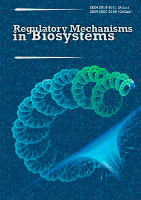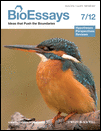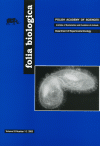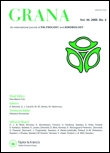
BIOLOGIA
Scope & Guideline
Championing excellence in biological research and communication.
Introduction
Aims and Scopes
- Aerobiology and Pollen Dynamics:
Research articles delve into the dynamics of airborne pollen and spores, including their concentrations, dispersal patterns, and their implications for health and environmental monitoring. - Bioaerosol Characterization:
Studies frequently assess the composition and impact of bioaerosols, including bacterial and fungal communities, in various environments such as urban, rural, and indoor settings. - Impact of Environmental Factors:
The journal highlights the interactions between environmental variables (e.g., pollution, climate) and biological particles, examining how these factors influence health outcomes and ecological dynamics. - Health Implications of Airborne Particles:
Research often investigates the health implications of exposure to airborne allergens and pathogens, emphasizing the relationship between air quality and public health. - Technological Advances in Monitoring:
The journal publishes innovative methodologies for monitoring airborne biological particles, including advancements in automatic detection and analysis techniques.
Trending and Emerging
- Climate Change and Airborne Allergens:
Research increasingly focuses on the impact of climate change on pollen production and distribution, highlighting the health risks associated with changing allergenic profiles. - Integration of AI in Aerobiology:
There is a growing trend towards incorporating artificial intelligence and machine learning in the monitoring and analysis of pollen and bioaerosol data, enhancing predictive capabilities. - Health Risk Assessment Related to Bioaerosols:
An emerging theme involves the assessment of health risks associated with bioaerosols, particularly in connection to respiratory diseases and allergies, as public health concerns rise. - Microbial Diversity in Airborne Samples:
Studies focusing on the diversity of microbial communities in the air, including their ecological roles and potential pathogenicity, are increasingly prominent. - Real-Time Monitoring Technologies:
The journal is seeing a rise in research dedicated to the development and implementation of real-time monitoring technologies for airborne biological particles, reflecting a shift towards timely data collection.
Declining or Waning
- Traditional Indoor Air Quality Studies:
Research focusing solely on traditional indoor air quality without integrating biological aspects has seen a decline, as the journal increasingly emphasizes the role of bioaerosols. - Historical Context of Aerobiology:
Studies that primarily focus on historical data or past events in aerobiology are becoming less frequent, as the journal shifts towards current trends and real-time monitoring. - General Environmental Studies:
While the journal still publishes articles related to environmental science, there is a noticeable decrease in generalized environmental studies that do not specifically address the biological components of air quality.
Similar Journals

Regulatory Mechanisms in Biosystems
Bridging Disciplines for a Deeper Understanding of BiosystemsRegulatory Mechanisms in Biosystems (ISSN: 2519-8521, E-ISSN: 2520-2588) is an esteemed open-access journal published by the OLES HONCHAR DNIPROPETROVSK NATIONAL UNIVERSITY in Ukraine. Since its establishment in 2017, the journal has been dedicated to advancing knowledge in the dynamic fields of biochemistry, genetics, molecular biology, as well as relevant interdisciplinary domains. Although it currently holds a Q4 ranking across multiple categories—including Biochemistry, Microbiology, and Pharmacology—it provides a vital platform for researchers and professionals to disseminate innovative findings and insights. With a commitment to fostering collaboration and dialogue within the scientific community, Regulatory Mechanisms in Biosystems plays a crucial role in promoting open access research that contributes to our understanding of complex biological systems, ultimately guiding evidence-based practices in health and environmental sciences. The journal invites scholars to submit diverse articles covering both theoretical and empirical studies that reflect the multifaceted nature of regulatory mechanisms in biological systems.

AEROBIOLOGIA
Bridging Science and Application in Aerobiological StudiesAEROBIOLOGIA is an esteemed journal published by SPRINGER, dedicated to the dynamic fields of Immunology, Allergy, and Plant Science. With a history of scholarly contributions dating back to 1985, this journal serves as a critical platform for researchers and professionals to share advancements and findings in the understanding of airborne biological particles and their implications on health and biodiversity. As evidenced by its Q2 and Q3 quartile rankings in various categories as of 2023, AEROBIOLOGIA holds a significant position within the academic community, particularly in the realms of Agricultural and Biological Sciences. The journal encourages high-quality submissions and remains committed to fostering innovation and collaboration among scientists dedicated to the exploration of aerobiological phenomena. While it is not an open-access publication, its rich repository of research is crucial for academia and industry practitioners alike, facilitating essential insights into ecological interactions and immunological responses.

JOURNAL OF PEST SCIENCE
Connecting ecology and agronomy for effective pest management.JOURNAL OF PEST SCIENCE, published by SPRINGER HEIDELBERG, is a premier academic journal dedicated to the multidisciplinary study of pest management, contributing significantly to the fields of Agronomy, Ecology, and Insect Science. With a history that spans back to 1925, this journal has established itself as a critical platform for disseminating innovative research, evidenced by its impressive Q1 rankings in multiple categories, including Ecology and Plant Science, as of 2023. The journal particularly excels in its contribution to Agricultural and Biological Sciences, holding a remarkable 98th percentile rank in Insect Science. By fostering open access, the JOURNAL OF PEST SCIENCE ensures broader dissemination and engagement with scientific advancements pertinent to pest control and management practices. Its commitment to publishing high-quality, peer-reviewed articles makes it an essential resource for researchers, professionals, and students looking to stay at the forefront of pest science and its application to sustainable agriculture and ecology.

ZOOLOGICHESKY ZHURNAL
Pioneering research in zoology for over seven decades.Zoologichesky Zhurnal, a prominent journal in the field of Ecology, Evolution, Behavior and Systematics, has been a vital publication since its inception in 1950. Published by MAIK Nauka-Interperiodica in the Russian Federation, this journal has established a notable reputation in disseminating scientific research and advancing knowledge in zoology. With its coverage spanning from 1950 to 2023, and a specific convergent focus during 1982-1983, this journal contributes significantly to the ecological and evolutionary sciences, even though it currently holds a Q4 classification in the 2023 category quartiles, indicating its niche positioning among peers. Researchers and students engaged in the study of biological sciences, particularly those interested in the dynamics of ecosystems, behavior of species, and evolutionary processes, will find valuable insights and original research articles within its pages. While access to this esteemed journal is not open, it remains an essential resource for those seeking to deepen their understanding of zoological sciences.

Biology-Basel is a premier, peer-reviewed open-access journal published by MDPI since 2012, situated in the heart of Switzerland. With an E-ISSN of 2079-7737, this journal serves as a vital platform for the dissemination of innovative research across the broad spectrum of Agricultural and Biological Sciences, Biochemistry, Genetics, Molecular Biology, and Immunology. Recognized for its rigorous editorial standards and impactful findings, it currently ranks Q1 in Agricultural and Biological Sciences and holds impressive positions in several categories according to the 2023 Scopus rankings. The journal’s open-access model ensures that high-quality research is freely available to a global audience, fostering collaboration and knowledge sharing among researchers, professionals, and students alike. Spanning from 2012 to 2024, Biology-Basel is committed to reflecting the latest advancements in biological sciences, making it an essential resource in the ever-evolving landscape of biological research.

BIOESSAYS
Pioneering Insights in Biochemistry and GeneticsBIOESSAYS, published by WILEY, is a leading academic journal dedicated to the dynamic fields of biochemistry, genetics, and molecular biology. With an impressive impact factor and recognized as a Q1 journal in its category for 2023, it ranks 49 out of 221 in the Scopus database, placing it within the 78th percentile among its peers. Since its inception in 1984, BIOESSAYS has served as a vital platform for researchers, professionals, and students, facilitating the dissemination of pivotal findings, innovative theories, and review articles that shape the current understanding of biological sciences. Although it does not offer open access, the journal remains key for those seeking to stay at the forefront of scientific discovery and discussion within this ever-evolving discipline. With its commitment to high-quality, peer-reviewed content, BIOESSAYS continues to influence future research directions and academic discourse.

FOLIA BIOLOGICA-KRAKOW
Fostering critical dialogue in evolutionary and ecological sciences.FOLIA BIOLOGICA-KRAKOW, published by the renowned Polish Academy of Sciences, Institute of Systematics and Evolution of Animals, serves as a pivotal platform for advancing research in the fields of Biochemistry, Genetics, and Molecular Biology. Since its inception in 1953, this journal has consistently contributed to the academic dialogue, focusing on a diverse range of topics, including evolutionary biology, molecular genetics, and ecological biochemistry. Although currently classified in Q4 quartiles according to the 2023 categorizations in both Biochemistry, Genetics and Molecular Biology (miscellaneous) and Medicine (miscellaneous), its dedicated efforts to disseminate critical findings and foster scholarly exchange ensure its relevance and growth in the scientific community. FOLIA BIOLOGICA-KRAKOW is not Open Access, but researchers can access its publications through institutional subscriptions or library services, making it a valuable resource for scientists seeking to enrich their understanding of biological processes. With its commitment to excellence and innovation in biological research, this journal remains an essential reference for researchers, professionals, and students alike, contributing significantly to the evolution of contemporary biological sciences.

Environmental Science-Atmospheres
Connecting minds through open-access environmental research.Environmental Science-Atmospheres is an emerging and dynamic open-access journal published by the Royal Society of Chemistry, dedicated to advancing research in the fields of environmental science and atmosphere-related studies. Launched in 2021, this journal serves as an essential platform for disseminating cutting-edge findings that address the complexities of atmospheric phenomena, pollution impacts, and overall environmental health. With a commendable Q2 ranking across various categories including Environmental Chemistry and Pollution, it solidifies its position as a vital resource for researchers, professionals, and students seeking to contribute to the understanding of environmental dynamics. The journal is indexed in Scopus, providing its contributors with significant visibility within the scientific community. Operating under a fully Open Access model since its inception, Environmental Science-Atmospheres ensures that research outputs are freely accessible, fostering collaboration and knowledge sharing essential for tackling global environmental challenges.

Folia Oecologica
Unveiling Insights into Our Natural World.Folia Oecologica is a distinguished open-access journal published by WALTER DE GRUYTER GMBH, focusing on critical research in the fields of agricultural and biological sciences, ecology, and forestry. Established as a vital platform for the dissemination of knowledge, this journal has been providing free access to its valuable content since 2017, catering to an international audience engaged in environmental and ecological studies. With its ISSN 1336-5266 and E-ISSN 1338-7014, Folia Oecologica has earned notable ranks in Scopus, placing it in the 62nd percentile for Agricultural and Biological Sciences and the 50th percentile for Environmental Science. The journal's commitment to high-quality research is reflected in its positions in the Q2 and Q3 quartiles across various categories in 2023. As it converges years from 2006 to 2024, Folia Oecologica continues to foster scholarly dialogue and collaboration among researchers, professionals, and students, making significant contributions to the understanding and preservation of our ecological systems.

GRANA
Unveiling the Secrets of Plant Evolution and EcologyGRANA is a prestigious peer-reviewed journal published by Taylor & Francis AS, dedicated to advancing the field of Ecology and Plant Science. With a history dating back to the early 1970s and continuing through to 2024, GRANA serves as a critical platform for researchers and professionals exploring the intricate relationships within plant communities, ecological dynamics, and evolutionary processes. Despite its Q3 quartile ranking in both Ecology, Evolution, Behavior and Systematics and Plant Science, it stands out for its rigorous publication standards and relevance in the scientific community. The journal holds a rank of #283/516 in Plant Science and #410/721 in Ecology, reflecting its commitment to producing impactful research. Although it currently does not offer an open access model, GRANA provides vital insights that are indispensable for academics, practitioners, and students eager to deepen their understanding of ecological and botanical sciences.